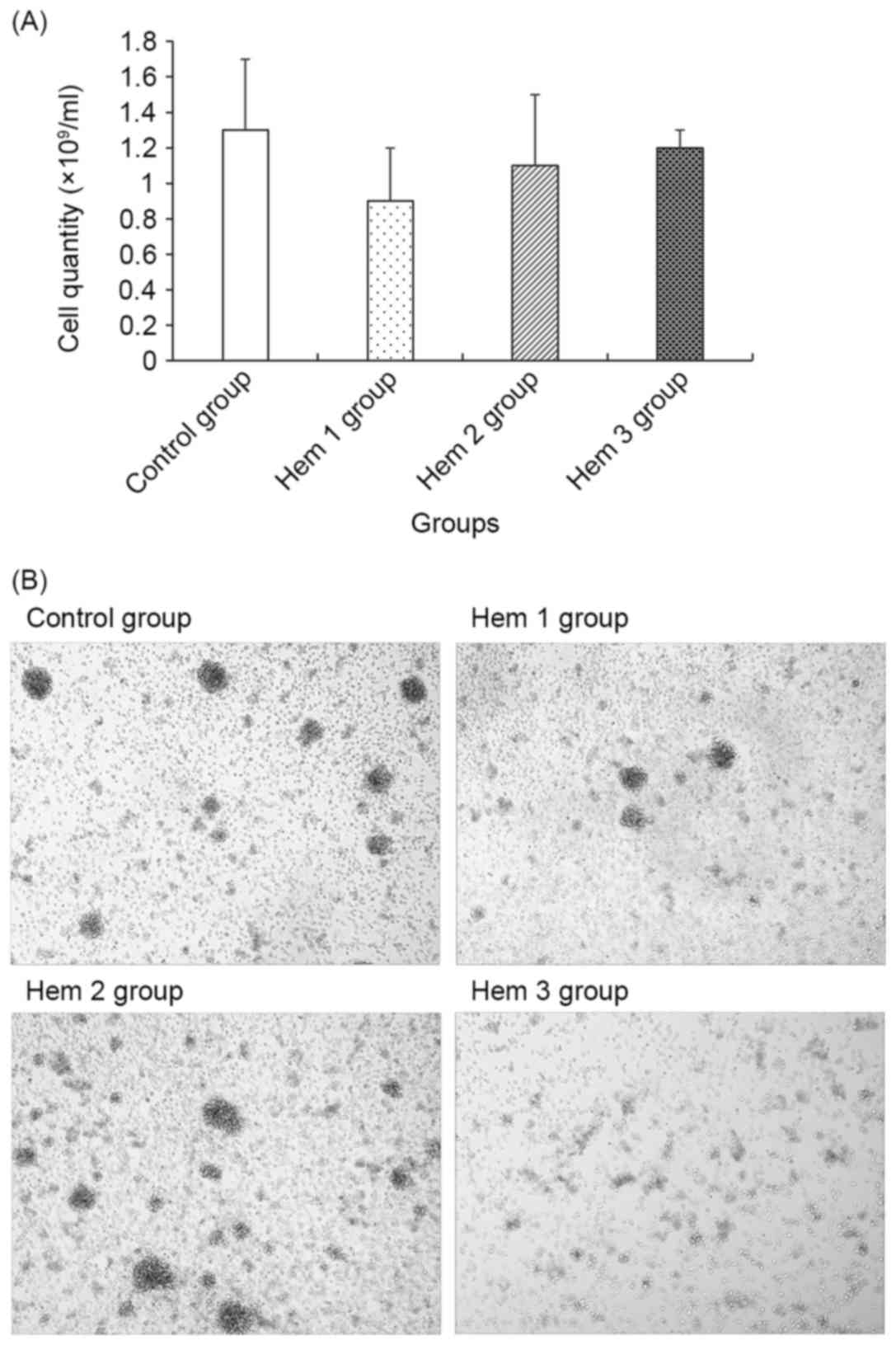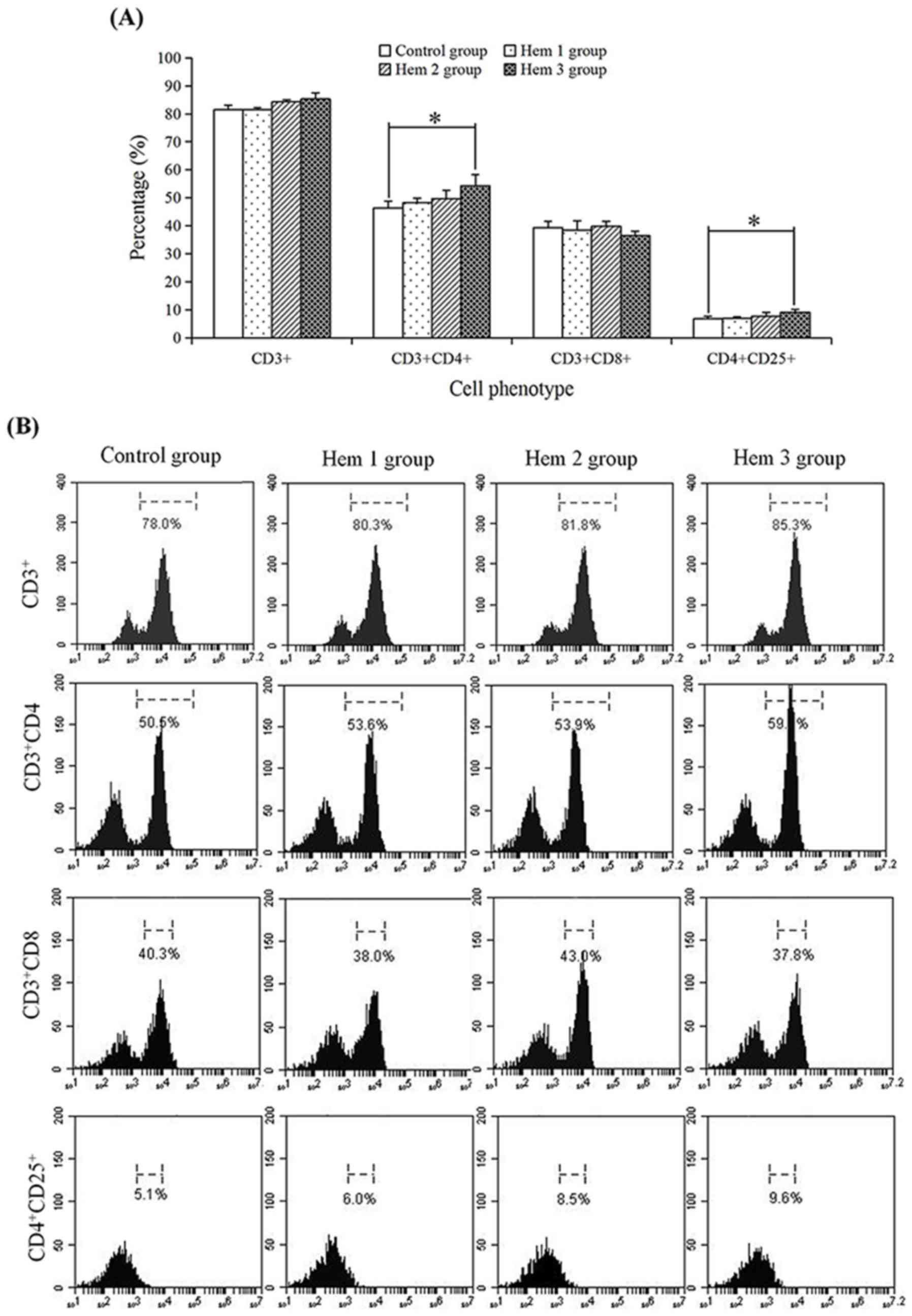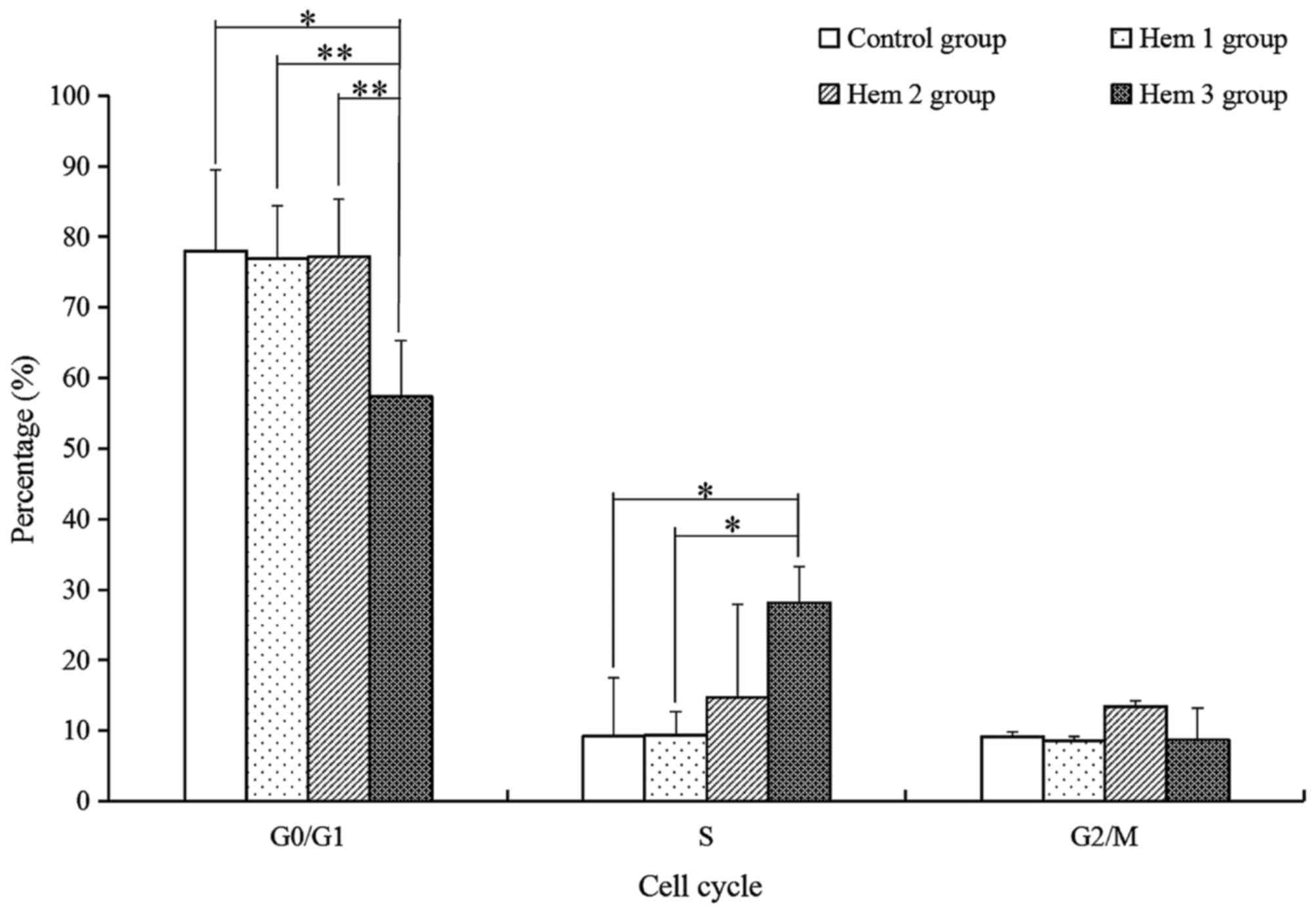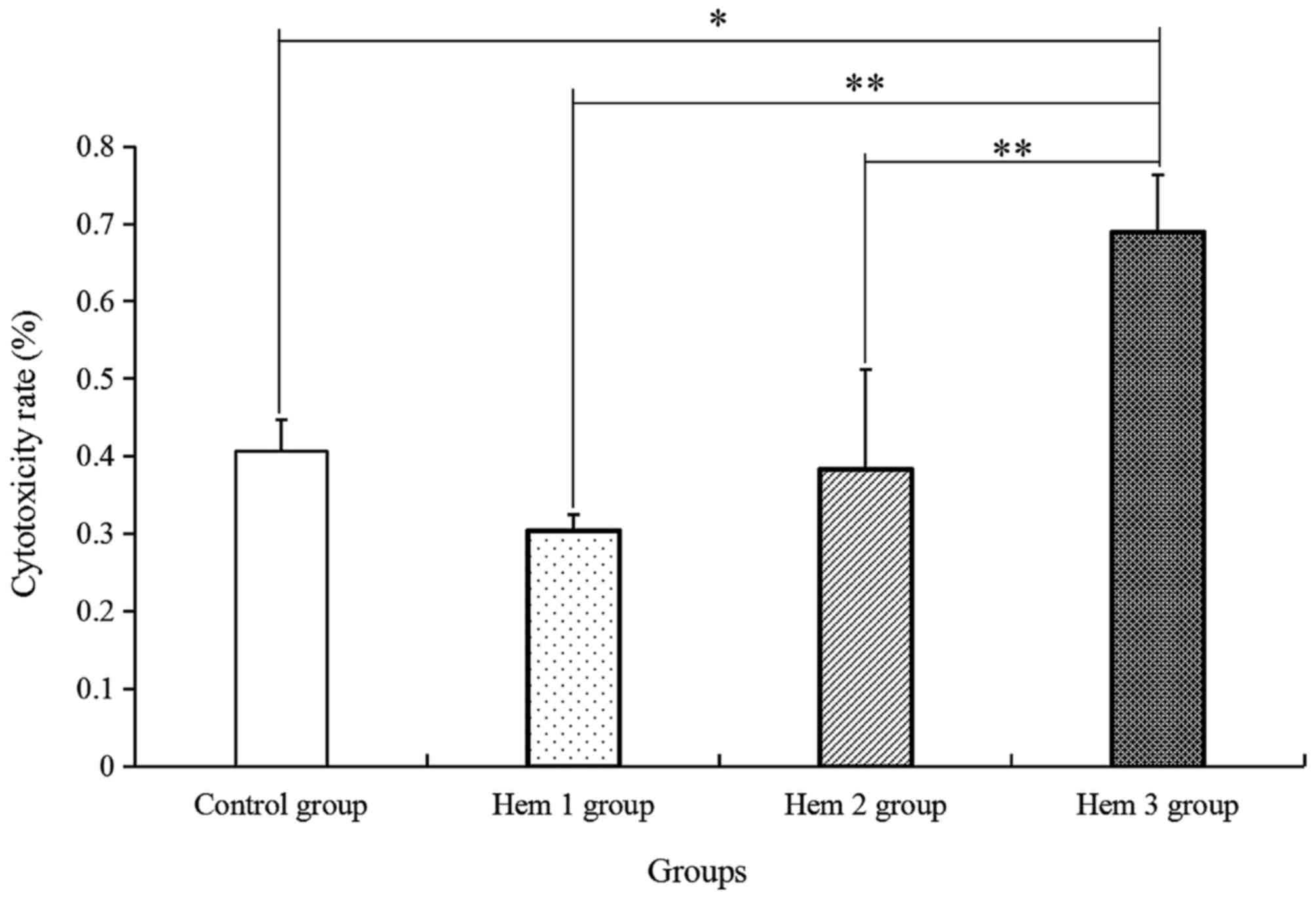The effects of hemocyanin on T cells cultured in vitro
- Authors:
- Published online on: December 11, 2017 https://doi.org/10.3892/ol.2017.7587
- Pages: 2655-2660
Abstract
Introduction
T cell adoptive immunotherapy is widely used in clinical settings, and gentamicin is used extensively in T cell cultures in vitro as a broad-spectrum antibiotic (1–3). However, our previous study identified that T cell activity was inhibited by gentamicin (4). Hemocyanin was selected as an additive for T cell culture in vitro in order to maintain the antibacterial environment and enhance the activity of T cells.
Hemocyanin was identified in mollusks and arthropods as a respiratory protein (5). In addition to this primary function, hemocyanin performs multiple roles in immune defense, functioning similarly to a phenoloxidase-like enzyme (6), an antiviral agent (7), an antimicrobial protein (8) and agglutinin (9). Notably, Min et al (10) identified that 2 hemocyanin fractions from Litopenaeus vannamei (L. vannamei) exhibited hemolytic activity, which was likely associated with the diversity in amino acid sequence and glycosylation of the IgG fractions. Zheng et al (11) demonstrated that the hemocyanin from L. vannamei exhibited antiproliferative properties against HeLa cells in vitro through mediating the apoptosis mechanism via the mitochondria triggered pathway. Gesheva et al (12) noted that the hemocyanin from Rapana thomasiana and Helix pomatia presented marked anticancer and antiproliferative effects in a murine colon carcinoma model. Although hemocyanin had been identified as a multifunctional protein with antimicrobial and anticancer activities, the effects of hemocyanin from L. vannamei on human T cells is unclear.
In the present study, hemocyanin, as an antimicrobial protein, was incorporated into the culturing process of human T cells; the T cells in all groups were analyzed by optical microscopy and flow cytometry, and the results indicated that the application of hemocyanin to T cells cultured in vitro has a beneficial effect.
Materials and methods
The peripheral blood was donated by healthy male volunteers (age, 25–35 years) who provided of verbal informed consent, and the present study was approved by the Animal Welfare and Research Ethics Committee of the University of South China (Henan, China). The hemocyanin, which was purified by gel filtration chromatography on a Sepharose 4B column from L. vannamei and stored in PBS buffer (0.01 mol/l, pH 7.4), was donated by Professor Yueling Zhang from Shantou University (Shantou, China).
T cells cultured in vitro and microscopic examination
T cells were cultured with 80 U/ml gentamicin (Yichang Humanwell Pharmaceutical Co., Ltd., Yichang, China), and were defined as the control group. T cells cultured with 0.05, 0.1 and 0.2 µg/ml hemocyanin were defined as Hem 1, 2 and 3 groups, respectively.
Lymphocytes were separated and cultured as described previously (13), with certain modifications: Peripheral blood with heparin sodium anticoagulant was centrifuged at 450 × g at room temperature for 5 min. The plasma was collected and maintained at 4°C subsequent to inactivation at 56°C for 30 min, then centrifuged at 648 × g at room temperature for 10 min. The supernatant was collected and stored at 4°C as autologous plasma. The peripheral blood cell layer was mixed 1:1 (v/v) with 0.9% saline and used for Ficoll® density gradient separation (LymphoPrep; PAA Laboratories GmbH, Cölbe, Germany). Following centrifugation at 648 × g at room temperature for 20 min, the leukocyte layer was collected in new tubes. Then, the cells were washed twice with 0.9% saline and centrifuged at 450 × g at room temperature for 7 min. Subsequently, the lymphocytes were cultured in GT-T551 medium (Takara Biotechnology Co., Ltd., Dalian, China) with 1,000 U/ml γ-interferon (Beijing Biocoen Biotechnology Co., Ltd., Beijing, China) and 10% autologous plasma was added. Following culture for 24 h at 37°C with 5% CO2, 50 µg/ml cluster of differentiation 3 (CD3) monoclonal antibody (Skoda Biotechnology Co., Ltd., Beijing, China) and 100 U/ml interleukin-1α (PeproTech China, Suzhou, China) were added on the first day, and 1,000 U/ml recombinant human interleukin-2 (SL Pharmaceutical Co., Ltd., Beijing, China) and 2% autologous plasma were included in the medium. The cells were cultured at 37°C and 5% CO2 for 9 days, and the T cells were analyzed by pocH-100i (Sysmex, Kobe, Japan) and an optical microscope (magnification, ×50) (Olympus Corporation, Tokyo, Japan).
T cell phenotype analysis
A total of 1 ml cell suspension was collected from each experimental group. Subsequent to centrifugation at 200 × g at room temperature for 10 min, the precipitate was resuspended in 0.9% saline and centrifuged again at 200 × g at room temperature for 10 min. Then, the precipitate was resuspended in 150 µl 0.9% saline and divided into two groups. The first group was an isotype control, and 5 µl allophycocyanin (APC) mouse IgG1 (1:10; cat. no. 555751), 5 µl fluorescein isothiocyanate (FITC) mouse IgG2α (1:10; cat. no. 555573), 5 µl phycoerythrin (PE) mouse IgG1 (1:10; cat. no. 555749) and 1 µl PerCP-CyTM5.5 mouse IgG1 (1:50; cat. no. 550795; all from BD Biosciences, Franklin Lakes, NJ, USA) were added. The second group was the experimental group, and 5 µl FITC mouse anti-human CD3 (1:10; cat. no. 555339), 5 µl PE mouse anti-human CD4 (1:10; cat. no. 555347), 1 µl PerCP-CyTM5.5 mouse anti-human CD8 (1:50; cat. no. 560662) and 5 µl APC mouse anti-human CD25 (1:10; cat. no. 555434; all from BD Biosciences) were added. All groups were incubated for 15 min at room temperature, resuspended in 1 ml 0.9% saline and then centrifuged again at 200 × g at room temperature for 10 min. Finally, the precipitate was resuspended in 200 µl 0.9% saline and prepared for detection with a BD Biosciences Accuri™ C6 Plus flow cytometer (BD Biosciences). The experiment was repeated in triplicate.
T cell cycle analysis
A total of 1 ml cell suspension was collected from each group and centrifuged at 200 × g at room temperature for 10 min, and the precipitate was resuspended in 0.9% saline. Following centrifugation at 200 × g at room temperature for 10 min, the precipitate was resuspended with 75% frozen ethanol and maintained at −20°C for 1 h. Then, samples were centrifuged at 200 × g at room temperature for 10 min. Then, the precipitate was resuspended with 200 µl 0.9% saline, and incubated with 10 µl propidium iodide (PI, 1 mg/ml; Sigma-Aldrich; Merck KGaA, Darmstadt, Germany) at room temperature for 30 min. Finally, the cell suspension was detected using a BD Accuri™ C6 Plus flow cytometer (BD Biosciences) and analyzed by FlowJo v.7.6.2 software (Tree Star, Inc., Ashland, OR, USA).
T cell cytotoxicity analysis
HepG2 (American Type Culture Collection, Manassas, VA, USA) were collected at logarithmic growth phase for use as target cells, and the concentration of cells was adjusted to 1×105 cells/ml. T cells for use as effector cells were cultured at 37°C and 5% CO2 for 9 days were resuspended with GT-T551 medium containing 2% autologous plasma and diluted to 5×106 cells/ml. These cells were divided into three groups: The effector-target group was 100 µl effector cells and 100 µl target T cells; the effector cell group comprised 100 µl effector cells and 100 µl GT-T551 medium; the target T cells group comprised 100 µl target T cells and 100 µl GT-T551 culture medium. All groups had 5 identical tubes, and were cultured at 37°C and 5% CO2 for 24 h. A total of 10 µl thiazolyl blue tetrazolium blue (5 mg/ml; Sigma-Aldrich; Merck KGaA) was added and cultured at 37°C and 5% CO2 for 4 h. Following centrifugation at 800 × g at room temperature for 5 min, the precipitate was dissolved in 100 µl dimethyl sulfoxide (Sigma-Aldrich; Merck KGaA), agitated for 15 min, and the optical density (OD) was detected at 490 nm. The killing rate was calculated as follows:
The killing rate (%) = [1 - (ODeffector-target T cells well - ODeffector cell well)/ODtarget T cells well] × 100%.
Statistical analysis
The data are presented as the mean ± standard deviation. Statistical analyses were performed using SPSS v.17.0 (SPSS, Inc., Chicago, IL, USA). Multiple comparisons between the groups were performed using one-way analysis of variance and the Bonferroni method as a post-hoc test. P<0.05 or P<0.01 were considered to indicate statistically significant differences. All experiments were repeated ≥3 times.
Results
Cell quantity and morphology assay
As demonstrated in Fig. 1, the cell quantity in the Hem 1, 2 and 3 groups gradually increased, though all were decreased compared with the control group. No significant difference between the control group and the Hem 1, 2 or 3 groups was observed.
Effect of hemocyanin on the T cell phenotype
To determine the effect of hemocyanin on T cells subsets, the proportions of CD3+, CD3+CD4+, CD3+CD8+ and CD4+CD25+ T cells were detected by flow cytometry (Fig. 2). In the control, Hem 1, 2 and 3 groups, the proportion of CD3+ (81.47, 81.53, 84.23 and 85.30%, respectively), CD3+CD4+ (46.40, 48.23, 49.73 and 54.33%, respectively) and CD4+CD25+ (6.77, 6.97, 7.63 and 9.10%) T cells were all increased with an increasing hemocyanin concentration, but no change was observed in the proportion of CD3+CD8+ T cells (39.37, 38.50, 39.83 and 36.47%). In addition, the proportions of CD3+CD4+ and CD4+CD25+ T cells in the Hem 3 group were respectively significantly increased 1.17-(P=0.02) and 1.34-fold (P=0.03) compared with the control group.
Effect of hemocyanin on T cell cycle distribution
For the subsequent analysis of the variety of T cells activity with hemocyanin treatment, the G0/G1, S and G2/M phase of T cells were analyzed with PI dye and a flow cytometry assay. As demonstrated in Fig. 3, the proportion of G0/G1 phase cells in the Hem 3 group were significantly decreased by 1.36-(P=0.012), 1.34-(P=0.002) and 1.34-(P=0.007) fold compared with the control, Hem 1 and 2 groups, respectively. The S phase cells of the Hem 3 group were significantly increased by 3.03-(P=0.027) and 3.01-(P=0.028) fold compared with the control and Hem 1 groups respectively, and increased by 1.91-(P=0.143) fold compared with Hem 2 group. No significant change in the G2/M phase proportion was observed among all groups.
Effect of hemocyanin on T cell cytotoxicity
Furthermore, the T cell cytotoxicity in HepG2 cells was verified. As indicated in Fig. 4, the T cell cytotoxicity in the Hem 1, 2 and 3 groups was gradually enhanced along with increases in the hemocyanin concentration, as compared with that in the control group. Among the four groups, T cell cytotoxicity in the Hem 3 group was significantly increased by 1.70-, 2.26- and 1.80-fold, compared with in the control, Hem 1 and 2 groups, respectively.
Discussion
Hemocyanin is a metallo-glycoprotein oxygen transporter, previously indicated to potentially have multiple functionalities (14). Hemocyanin has exhibited excellent antimicrobial (15–17), anti-tumor (18) and immune enhancement effects (19). In the present study, hemocyanin was used as an additive in T cell culture in vitro. The results indicated that the T cells normally proliferated during culture without gentamicin treatment, and the cell quantity between the control and experimental groups exhibited no significant changes (Fig. 1).
Furthermore, the CD3+, CD3+CD4+, CD3+CD8+ and CD4+CD25+ phenotypes, which all represent different T cell subsets, were analyzed by flow cytometry. CD3+ is the characteristic marker of T cells (20). The CD3+CD4+ phenotype is characteristic of T helper cells, which secret anti-tumor agents for cytotoxic T lymphocytes (21). T cells with the CD3+CD8+ phenotype are critical factors in the immune response to viral infection and cancer (22). CD4+CD25+ T cells are considered to be regulatory, and to serve a central role in the prevention of autoimmunity and in the control of immune responses (23). In the present study, the quantity of CD3+CD4+ and CD4+CD25+ T cells in the Hem 3 group were significantly increased compared with in the control group (Fig. 2). Therefore, 0.2 µg/ml hemocyanin may be an effective concentration for use in T cell culture in vitro.
In addition, the cell cycle distributions of the T cells were assayed using flow cytometry. Among the four groups (Fig. 3), the number of G0/G1 phase cells in the Hem 3 group was significantly decreased compared with in the control, Hem 1 and 2 groups. However, the number of S phase cells in the Hem 3 group was significantly elevated compared with in the control and Hem 1 groups. Chen et al (24) demonstrated that the cell proliferative activity corresponded with an increase in the number of S phase cells, therefore, 0.2 µg/ml hemocyanin may be beneficial for T cells proliferative activity.
T cell cytotoxicity in HepG2 was analyzed. In the present study, HepG2 cells were used for T cell cytotoxicity analysis. Although the HepG2 cell line has been demonstrated to be misidentified and be derived from hepatoblastoma instead of hepatocellular carcinoma (25), the use of HepG2 cells as a model of target cells derived from tumor tissues is suitable for cytotoxicity analysis of immune cells cultured in vitro (26–28). Among the four groups (Fig. 4), the T cell cytotoxicity in the Hem 1, 2 and 3 groups was gradually increased with the increased of hemocyanin concentration, and the T cell cytotoxicity of the Hem 3 group was significantly increased compared with the control, Hem 1 and 2 groups. Previous studies have indicated that this killing activity is a major characteristic of immune cells (29–31). Consequently, the results of the present study suggest that the concentration of hemocyanin used in the Hem 3 group may positively contribute to the anti-tumor activity of T cells.
In conclusion, the present study explored the possibility that hemocyanin may be used as an additive in T cell culture in vitro. The results verified that 0.2 µg/ml hemocyanin may significantly improve T cell proliferative activity and cytotoxicity, and have potential value in the application of T cell adoptive immunotherapy.
Acknowledgements
The authors would like to thank Professor Jianhua Xiao for the revision of the manuscript. This study was supported by the National Project of the Students in Local Colleges and Universities Innovative Training Program in 2016 of China (no. 201610555010) and the project of Hunan Province Department of Education of China (no. 2016-283).
References
|
Batorov EV, Shevela EY, Tikhonova MA, Batorova DS, Ushakova GY, Sizikova SA, Sergeevicheva VV, Gilevich AV, Kryuchkova IV, Ostanin AA and Chernykh ER: Mesenchymal stromal cells improve early lymphocyte recovery and T cells reconstitution after autologous hematopoietic stem cell transplantation in patients with malignant lymphomas. Cell Immunol. 297:80–86. 2015. View Article : Google Scholar : PubMed/NCBI | |
|
Huang J, Li C, Wang Y, Lv H, Guo Y, Dai H, Wicha MS, Chang AE and Li Q: Cytokine-induced killer (CIK) cells bound with anti-CD3/anti-CD133 bispecific antibodies target CD133 (high) cancer stem cells in vitro and in vivo. Clin Immunol. 149:156–168. 2013. View Article : Google Scholar : PubMed/NCBI | |
|
Gargett T and Brown MP: Different cytokine and stimulation conditions influence the expansion and immune phenotype of third-generation chimeric antigen receptor T cellss specific for tumor antigen GD2. Cytotherapy. 17:487–495. 2015. View Article : Google Scholar : PubMed/NCBI | |
|
Cao J, Yin W, Chen C and Luo X: Effects of autologous plasma and gentamicin on immunophenotype and viability of cytokine-induced killer cells. Xi Bao Yu Fen Zi Mian Yi Xue Za Zhi. 30:906–908. 2014.(In Chinese). PubMed/NCBI | |
|
Lu X, Lu H, Guo L, Zhang Z, Zhao X, Zhong M, Li S and Zhang Y: Cloning and characterization of a novel hemocyanin variant LvHMCV4 from shrimp Litopenaeus vannamei. Fish Shellfish Immun. 46:398–405. 2015. View Article : Google Scholar | |
|
Zhao X, Guo L, Lu X, Lu H, Wang F, Zhong M, Chen J and Zhang Y: Evidences of abundant hemocyanin variants in shrimp Litopenaeus vannamei. Mol Immunol. 77:103–112. 2016. View Article : Google Scholar : PubMed/NCBI | |
|
Zhang X, Huang C and Qin Q: Antiviral properties of hemocyanin isolated from shrimp Penaeus monodon. Antiviral Res. 61:93–99. 2004. View Article : Google Scholar : PubMed/NCBI | |
|
Jiang N, Tan NS, Ho B and Ding JL: Respiratory protein-generated active oxygen species as an antimicrobial strategy. Nat Immunol. 8:1114–1122. 2007. View Article : Google Scholar : PubMed/NCBI | |
|
Zhang Y, Wang S, Xu A, Chen J, Lin B and Peng X: Affinity proteomic approach for identification of an IgA-like protein in Litopenaeus vannamei and study on its agglutination characterization. J Proteome Res. 5:815–821. 2006. View Article : Google Scholar : PubMed/NCBI | |
|
Min S, Yan F, Zhang Y, Ye X, Zhong M, Cao J, Zou H and Chen J: Characterization of a novel hemolytic activity of human IgG fractions arising from diversity in protein and oligosaccharide components. PLoS One. 9:e857112014. View Article : Google Scholar : PubMed/NCBI | |
|
Zheng L, Zhao X, Zhang P, Chen C, Liu S, Huang R, Zhong M, Wei C and Zhang Y: Hemocyanin from shrimp Litopenaeus vannamei has antiproliferative effect against Hela cell in vitro. PLoS One. 11:e01518012016. View Article : Google Scholar : PubMed/NCBI | |
|
Gesheva V, Chausheva S, Mihaylova N, Manoylov I, Doumanova L, Idakieva K and Tchorbanov A: Anti-cancer properties of gastropodan hemocyanins in murine model of colon carcinoma. BMC Immunol. 15:342014. View Article : Google Scholar : PubMed/NCBI | |
|
Cao J, Chen C, Wang Y, Chen X, Chen Z and Luo X: Influence of autologous dendritic cells on cytokine-induced killer cell proliferation, cell phenotype and antitumor activity in vitro. Oncol Lett. 12:2033–2037. 2016. View Article : Google Scholar : PubMed/NCBI | |
|
Coates CJ and Nairn J: Diverse immune functions of hemocyanins. Dev Comp Immnol. 45:43–55. 2014. View Article : Google Scholar | |
|
Zanjani NT, Miranda-Saksena M, Valtchev P, Diefenbach RJ, Hueston L, Diefenbach E, Sairi F, Gomes VG, Cunningham AL and Dehghani F: Abalone hemocyanin blocks the entry of HSV-1 into cells: A potential new antiviral strategy. Antimicrob Agents Chemother. 60:1003–1012. 2015. View Article : Google Scholar : PubMed/NCBI | |
|
Wen Y, Zhan S, Huang H, Zhong M, Chen J, You C, Wang F and Zhang Y: Identification and characterization of an 18.4 kDa antimicrobial truncation from shrimp Litopenaeus vannamei hemocyanin upon Vibrio parahaemolyticus infection. Fish Shellfish Immun. 56:450–458. 2016. View Article : Google Scholar | |
|
Destoumieux-Garzón D, Saulnier D, Garnier J, Jouffrey C, Bulet P and Bachère E: Crustacean immunity: Antifungal peptides are generated from the C terminus of shrimp hemocyanin in response to microbial challenge. J Biol Chem. 276:47070–47077. 2001. View Article : Google Scholar : PubMed/NCBI | |
|
Antonova O, Dolashka P, Toncheva D, Rammensee HG, Floetenmeyer M and Stevanovic S: In vitro antiproliferative effect of Helix aspersa hemocyanin on multiple malignan T cells lines. Z Naturforsch C. 69:325–334. 2014. View Article : Google Scholar : PubMed/NCBI | |
|
Guo D, Wang H, Zeng D, Li X, Fan X and Li Y: Vaccine potential of hemocyanin from Oncomelania hupensis against Schistosoma Japonicum. Parasitol Int. 60:242–246. 2011. View Article : Google Scholar : PubMed/NCBI | |
|
Zhang Q, Liu XY, Zhang T, Zhang XF, Zhao L, Long F, Liu ZK and Wang EH: The dual-functional capability of cytokine-induced killer cells and application in tumor immunology. Hum Immunol. 76:385–391. 2015. View Article : Google Scholar : PubMed/NCBI | |
|
Chen J, Wei Y, He J, Cui G, Zhu Y, Lu C, Ding Y, Xue R, Bai L, Uede T, et al: Natural killer T cells play a necessary role in modulating of immune-mediated liver injury by gut microbiota. Sci Rep. 4:72592014. View Article : Google Scholar : PubMed/NCBI | |
|
Salaun B, Yamamoto T, Badran B, Tsunetsugu-Yokota Y, Roux A, Baitsch L, Rouas R, Fayyad-Kazan H, Baumgaertner P, Devevre E, et al: Differentiation associated regulation of microRNA expression in vivo in human CD8+ T cells subsets. J Transl Med. 9:442011. View Article : Google Scholar : PubMed/NCBI | |
|
Fan R, Xiang Y, Yang L, Liu Y, Chen P, Wang L, Feng W, Yin K, Fu M, Xu Y and Wu J: Impaired NK cells' activity and increased numbers of CD4+CD25+ regulatory T cells in multidrug-resistant Mycobacterium tuberculosis patients. Tuberculosis (Edinb). 98:13–20. 2016. View Article : Google Scholar : PubMed/NCBI | |
|
Chen C, Wang ML, Jin C, Chen HJ, Li SH, Li SY, Dou XF, Jia JQ and Gui ZZ: Cordyceps militaris polysaccharide triggers apoptosis and G0/G1 cell arrest in cancer cells. J Asia-Pac Entomol. 18:433–438. 2015. View Article : Google Scholar | |
|
López-Terrada D, Cheung SW, Finegold MJ and Knowles BB: HepG2 is a hepatoblastoma-derived cell line. Hum Pathol. 40:1512–1515. 2009. View Article : Google Scholar | |
|
Huang J, Li C, Wang Y, Lv H, Guo Y, Dai H, Wicha MS, Chang AE and Li Q: Cytokine-induced killer (CIK) cells bound with anti-CD3/anti-CD133 bispecific antibodies target CD133(high) cancer stem cells in vitro and in vivo. Clin Immunol. 149:156–168. 2013. View Article : Google Scholar : PubMed/NCBI | |
|
El Ansary M, Mogawer S, Elhamid SA, Alwakil S, Aboelkasem F, Sabaawy HE and Abdelhalim O: Immunotherapy by autologous dendritic cell vaccine in patients with advanced HCC. J Cancer Res Clin Oncol. 139:39–48. 2013. View Article : Google Scholar : PubMed/NCBI | |
|
Liu H, Li J, Wang F, Gao Y, Luo Y, Wang P, Li C and Zhu Z: Comparative study of different procedures for the separation of peripheral blood mononuclear cells in cytokine-induced killer cell immunotherapy for hepatocarcinoma. Tumour Biol. 36:2299–2307. 2015. View Article : Google Scholar : PubMed/NCBI | |
|
Qu HQ, Zhou XS, Zhou XL and Wang J: Effect of DC-CIK cell on the proliferation, apoptosis and differentiation of leukemia cells. Asian Pac J Trop Med. 7:659–662. 2014. View Article : Google Scholar : PubMed/NCBI | |
|
Abdelrahman MM, Fawzy IO, Bassiouni AA, Gomaa AI, Esmat G, Waked I and Abdelaziz AI: Enhancing NK cell cytotoxicity by miR-182 in hepatocellular carcinoma. Hum Imuunol. 77:667–673. 2016. View Article : Google Scholar | |
|
Xue CM, Chen C, Xu J and Chen LR: Influence of some traditional Chinese medicines (TCMS) on cytokine-induced killer cells proliferation and anti-tumor features in vitro. Int J Res Ayurveda Pharm. 4:228–232. 2013. View Article : Google Scholar |













